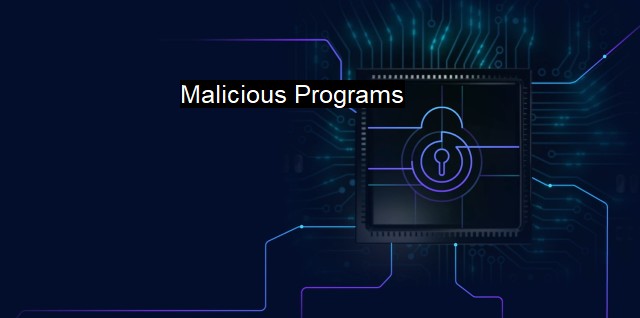What are Malicious Programs?
Combatting the Threat of Malware: Understanding the Different Forms and Protection Protocols in Cybersecurity
Malicious programs, also known as malware, constitute one of the major threats in the realm of cybersecurity today. As technological progress advances, so too does the sophistication and variety of these harmful pieces of software, hence increasing the need to comprehend their nature, functionality, as well as the means to protect against them. Understanding their adverse implications is a vital preparedness step for people and organizations as they navigate the complex digital landscape.Malicious programs pertain to any software designed to cause disruption to computer operations, gather sensitive information, gain unauthorized access, or conduct other harmful activities on a device’s operating system without the user's consent. Their types range from viruses, worms, trojans, botnets, to ransomware, spyware, among many others- all with varying operational mechanisms and damage potentials.
Malicious programs exploit vulnerabilities within software and operating systems, coupled with humans' propensity to be impelled by reactive psychological triggers manipulated by cybercriminals. These attacks can result in damage to an extent that has serious financial implications and, in some cases, global security risks, widely affecting the health, stability, and safety of organizations and governments.
Viruses, a subset of malicious programs, are contagious software programs that spread uncontrollably from one system to another, usually attached to other benign software. Generally, they lie dormant until triggered by a specific event or action. They can erase or rewrite data and messages, damaging the disk drive, crashing systems, or slowing processes.
Worms, another specialist type of malware, have a crucial distinction: they can self-replicate without the need to piggyback other programs. After infiltrating systems via vulnerabilities or lack of security controls, they look to spread across networks and, in some instances, can be used to establish backdoors for other malware.
Trojans, named after the infamous Trojan Horse from Greek mythology, appear benign or useful, disguising their true purpose. Instead, they serve as gateways for cybercriminals to infiltrate and usurp control of systems, enabling them to steal sensitive information or deploy other malicious programs.
Ransomware is particularly malicious, essentially holding digital assets hostage until a ransom is paid. These malicious programs restrict access to systems or vital files via encryption until a ransom, most commonly demanded in cryptocurrencies, is paid. Even upon payment, there’s uncertainty about the decryption key being sent or if the cybercriminal could stage repeat attacks.
Spyware is designed for covert operations, gathering valuable information about the user without their knowledge or consent. This act can be as seemingly innocuous as tracking browsing habits for targeted advertising or as intruding as accessing credit card information and secret trade data.
Safeguarding systems against these nefarious software programs necessitates multi-tiered and constant vigilance. Antivirus and anti-malware software are the front line of defense, capable of scanning, detecting, and eliminating known threats and vulnerabilities from systems. Regular software and systems updates fortify defenses by patching discovered vulnerabilities that could be exploited by malicious programs.
As smart as technology is, it falls short without human vigilance. Many malicious program attacks exploit human weaknesses and gullibility, using social engineering tactics to trick individuals into downloading malicious software without their knowledge. Thus, cybersecurity awareness initiatives are critical countermeasures, arming individuals not just with knowledge of safe online behavior, but also early detection skills for any unusual computer activities.
Malicious programs pose severe cybersecurity threats, intricately woven into the fabric of everyday digital interaction. Ranging from scams to direct attacks, these clandestine threats continue to put significant data, personal and institutional, in harm's way. As such, the cogs in the machinery of digital security, from individuals to organizations, are duty-bound to their awareness and swift responsiveness towards malicious programs and the complications they present. As the adage goes, forewarned is forearmed.

Malicious Programs FAQs
What are malicious programs?
Malicious programs are software programs designed with the intent to harm or damage computer systems, steal sensitive information, or cause disruption in computer networks. They can be transmitted via various mediums such as email attachments, infected websites, or through file-sharing programs.What types of malicious programs exist?
There are many types of malicious programs, such as viruses, worms, Trojans, ransomware, spyware, adware, and rootkits. Each type has its own unique characteristics and methods of attack.Why is it important to have antivirus software?
Antivirus software is crucial in protecting your computer system from malicious programs. It helps detect and remove any threats that may exist on your system and can prevent future attacks. Without antivirus software, you leave your system vulnerable to potentially damaging attacks that can result in data loss or identity theft.How can I protect myself from malicious programs?
To protect yourself from malicious programs, make sure you have a reputable antivirus software installed on your computer system. Keep your software and operating system updated with the latest security patches. Be cautious when opening email attachments or downloading files from unknown sources. Avoid clicking on suspicious links or pop-up ads. Finally, backup your important data on a regular basis to ensure that you can restore it if it is lost or damaged.| | A | | | B | | | C | | | D | | | E | | | F | | | G | | | H | | | I | | | J | | | K | | | L | | | M | |
| | N | | | O | | | P | | | Q | | | R | | | S | | | T | | | U | | | V | | | W | | | X | | | Y | | | Z | |
| | 1 | | | 2 | | | 3 | | | 4 | | | 7 | | | 8 | | |||||||